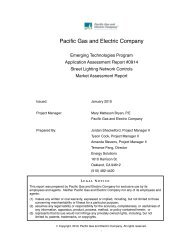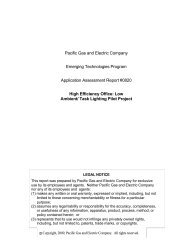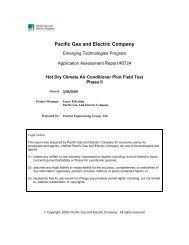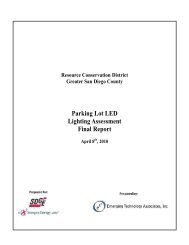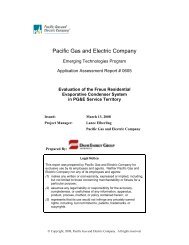Laboratory Evaluation of the OASys Indirect/Direct Evaporative
Laboratory Evaluation of the OASys Indirect/Direct Evaporative
Laboratory Evaluation of the OASys Indirect/Direct Evaporative
Create successful ePaper yourself
Turn your PDF publications into a flip-book with our unique Google optimized e-Paper software.
Blower<br />
Figure 7: Test Facility and Measurement Locations<br />
(The numbers correspond to <strong>the</strong> descriptions <strong>of</strong> <strong>the</strong> instruments in <strong>the</strong> next section)<br />
Control Room<br />
Nozzle<br />
Chamber<br />
Δ<br />
T<br />
P 15<br />
D 5<br />
Supply<br />
491-06.12.doc 8<br />
12<br />
1<br />
Pitot Tube<br />
Airflow Sensor<br />
(attached to ceiling plenum)<br />
Δ 16<br />
Test<br />
Unit<br />
P 6<br />
T<br />
Exhaust<br />
Duct<br />
T Dry Bulb Temperature P<br />
D Dew Point Temperature Δ<br />
4<br />
T<br />
14<br />
11<br />
10<br />
13<br />
P 9<br />
D 8<br />
T 7<br />
Intake<br />
T 2<br />
D 3<br />
Humidifier<br />
Blower<br />
Nozzle<br />
Chamber<br />
(Unused)<br />
Static Pressure<br />
Differential Pressure<br />
20 Ton<br />
Chiller<br />
Heater<br />
Measurements and Instrumentation<br />
The test set-up followed <strong>the</strong> guidelines described in <strong>the</strong> ASHRAE evaporator cooler test standards<br />
(References 4 and 5). The following is a listing <strong>of</strong> <strong>the</strong> measurements taken and <strong>the</strong> instruments used for<br />
<strong>the</strong> testing:<br />
1. Barometric pressure, using an electronic barometer.<br />
2. Intake air dry-bulb temperature, using four resistance temperature devices (RTDs).<br />
3. Intake air dew-point temperature, using a chilled mirror sensor.<br />
4. Supply air dry-bulb temperature, using six RTDs (located about 8” downstream from unit outlet)<br />
5. Supply air dew-point temperature, using a chilled mirror sensor.<br />
6. Supply static pressure, using a low-range static pressure transmitter.<br />
Four taps were made in <strong>the</strong> supply duct at <strong>the</strong> middle <strong>of</strong> each duct face. The taps were connected<br />
toge<strong>the</strong>r with a ring <strong>of</strong> tubing and tees, with an additional tee leading to <strong>the</strong> transmitter.<br />
7. Exhaust air dry-bulb temperature, using six RTDs inserted through <strong>the</strong> duct wall.<br />
8. Exhaust air dew-point temperature, using a chilled mirror sensor and a sampling tube.<br />
9. Exhaust static pressure, using a low-range static pressure transmitter.<br />
10. Inter-stage air dry-bulb temperature, using six RTDs inserted through <strong>the</strong> test unit enclosure.<br />
11. Water basin temperature, using two RTDs.<br />
12. Total power, using a true-RMS power meter.




